At Northwestern, students watch climate change through maple trees
EVANSTON, Ill. (AP) — Big Mama has seen a lot of students passing by in her 120 years. So have Little Mama, Big Bertha, Persephone, Doug and Grant — just some of the many sugar maple trees on Northwestern University’s campus that have provided not only sap, but also data to students doing a course on maple syrup and climate change.
It’s a class that the students, who come from majors ranging from environmental policy and journalism to civil engineering, say provides hands-on experience in data collection and a front-row seat to witness climate change. It’s also a highly sought-after course and one that students say more programs should emulate with its incorporation of Indigenous knowledge. Many current and former students are passionate about the environment and are keen on learning more about environmental justice and Native perspectives.
But less than one percent of Northwestern’s benefits-eligible staff in the 2020 and 2021 academic years identified as American Indian or Alaska Native — a statistic that follows a nationwide trend, which, as of fall of 2021, indicated that the same group made up less than one-half of one percent of college faculty in the U.S., according to the National Center for Education Statistics. Northwestern says it’s actively working to enhance its Native and Indigenous presence on campus, including through faculty recruitment, and is proud of the quality of its Indigenous faculty.
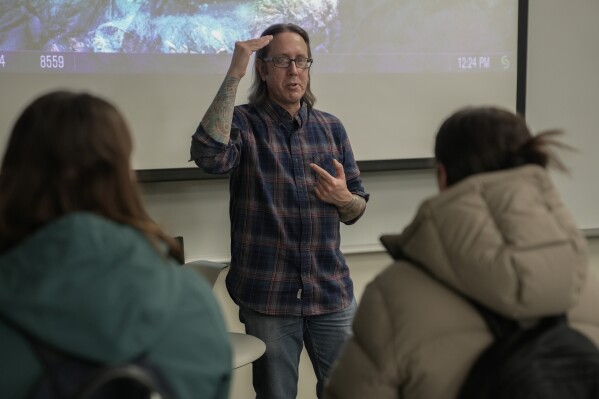
Eli Suzukovich III, center, the instructor, talks with students Olivia Schenker, left and Ashley Berson, right, following his class on maple syrup and climate change, Friday, Feb. 23, 2024, at Northwestern University in Evanston, Ill. It’s a class that the students, who come from a variety of majors, say is providing hands-on experience in data collection and a front-row seat to witness climate change. (AP Photo/Joshua A. Bickel)
The maple course instructor, Eli Suzukovich III, is of the Little Shell Tribe of Chippewa/Cree and first came to the idea of tapping urban trees in 2012, when he was working for the American Indian Center in Chicago. He says he and his colleagues realized it was a good outdoor activity for winter and early spring, and built a curriculum around the practice. “It was largely for Native kids, as a way to think about climate change and environment from a Native perspective, but also thinking about Native traditions,” he said.

Now, he’s adapted that curriculum, in partnership with associate professor of chemistry Shelby Hatch, for Northwestern students, who have been taking the class for about seven years. “In seven years I’ve had seven different winters,” Suzukovich III said. “The only thing I can know that’s consistent is that the trees will produce sap at some point.”
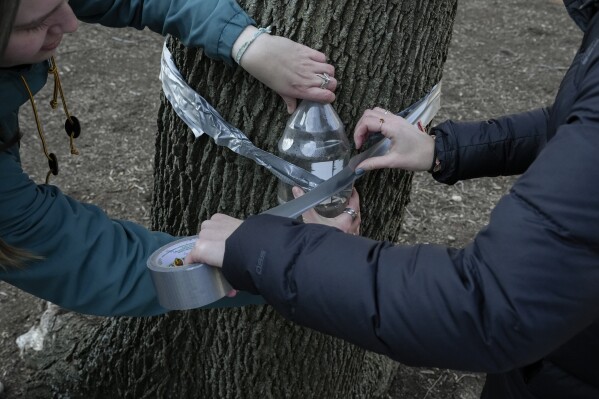
Olivia Schenker, left, and Zella Milfred, right, tape a plastic bottle to a maple tree for sap collection during their class on maple syrup and climate change, Friday, Feb. 23, 2024, at Northwestern University in Evanston, Ill. It’s a class that the students, who come from a variety of majors, say is providing hands-on experience in data collection and a front-row seat to witness climate change. (AP Photo/Joshua A. Bickel)
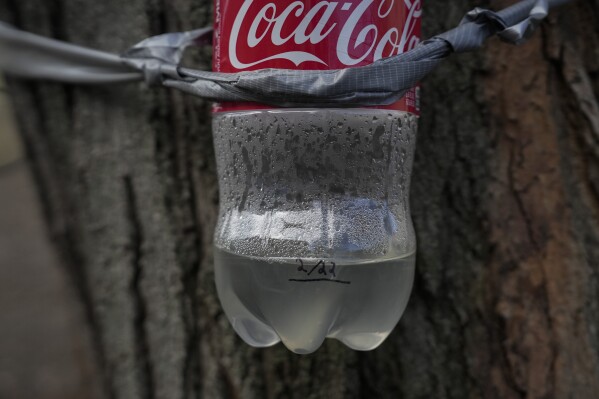
A plastic bottle holds collected sap from a maple tree, Friday, Feb. 23, 2024, at Northeastern University in Evanston, Ill. It’s a class that the students, who come from a variety of majors, say is providing hands-on experience in data collection and a front-row seat to witness climate change. (AP Photo/Joshua A. Bickel)
This year, through hail and freezing rain, students calculated the trees’ heights. Next, they tapped through layers of bark to get to the sap that flows through their trunks, and tested the sugar content of that sap using a special tool called a refractometer. Eventually, they’ll boil into maple syrup what they catch in plastic containers duct taped to the side of each tree.
“I’ve loved this class and just the opportunity to learn through doing,” said Zella Milfred, a junior who grew up organizing around climate issues in Madison, Wisconsin. One of her fellow class project group members, sophomore Bela Filstrup, also grew up engaged in climate activism and says it was important to her to have a strong science background as well as to study connections between climate and environmental justice. “Getting to know your environment a lot more and having just so much more respect of the land, I think is really important,” she said.
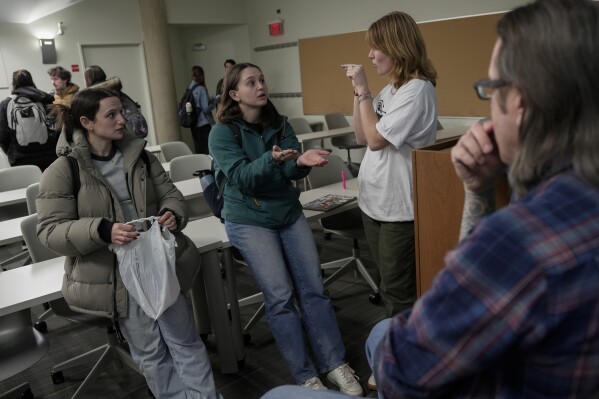
Students Ashley Berson, from left, Olivia Schenker and Zella Milfred talk as instructor Eli Suzukovich III, right, listens following a class on maple syrup and climate change, Friday, Feb. 23, 2024, at Northwestern University in Evanston, Ill. (AP Photo/Joshua A. Bickel)
Forrest Bruce, a former student of the class who is now a fifth-year Ph.D. candidate interested in climate change education for Native youth, also said he appreciated the course for allowing him to connect with the land and for its focus on adaptation.
“I think, like a lot of our young people are bombarded with this narrative that...you are the generation that is going to have to live through climate collapse,” Bruce said. “It’s important not to downplay the severity of the situation that we’re in, but also I think that cultivating climate anxiety like that can be paralyzing.”
He said that he doesn’t think the class should be exceptional and that more should be done to connect Indigenous education with climate curricula on campus.
“Our ancestors, they always found ways to adapt and to change with the times. And so we’re continuing that tradition,” he said.
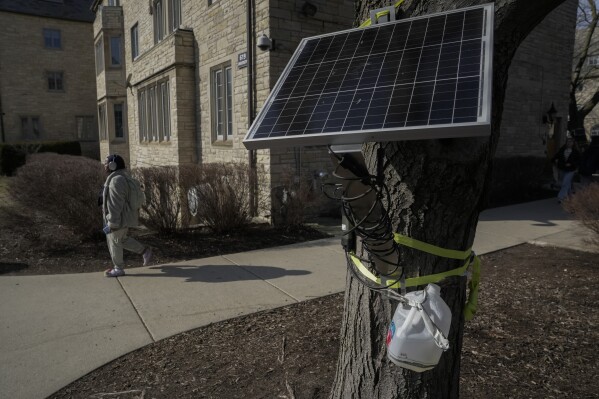
A plastic jug collects maple sap as a solar panel powers sensors measuring the movement of sap through the tree, Friday, Feb. 23, 2024, at Northwestern University in Evanston, Ill. (AP Photo/Joshua A. Bickel)
___
Associated Press journalist Joshua A. Bickel contributed to this report.
___
Follow Melina Walling on X: @MelinaWalling.
___
The Associated Press’ climate and environmental coverage receives financial support from multiple private foundations. AP is solely responsible for all content. Find AP’s standards for working with philanthropies, a list of supporters and funded coverage areas at AP.org.
Disclaimer: The copyright of this article belongs to the original author. Reposting this article is solely for the purpose of information dissemination and does not constitute any investment advice. If there is any infringement, please contact us immediately. We will make corrections or deletions as necessary. Thank you.





